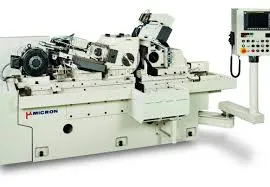A centerless grinding process is an outside-diameter grinding process. The procedure entails removing material from components or items using abrasive cutting or grinding. It differs from centered grinding. In that, the material on which the work is being done is not held in place by a spindle. Instead, it’s held in place by a pair of rotating grinding wheels that spin at predetermined speeds. A centerless grinding machine can achieve precision in cylindrical surfaces, roundness, and exceptional accuracy when processing high-volume automotive components and hydraulic and fluid control parts.
Fundamentals of Centerless Grinding
The Centerless Grinding process requires a thorough understanding of the fundamentals to get consistent and high-quality outcomes. The workpiece is fastened between two grinding wheels in centerless grinding, wherein the rotatory grinding wheel’s speed is determined by the rate at which material is removed from the workpiece. Compared to the workpiece, the grinding wheel rotates along a fixed axis and has a higher angular velocity. The regulating wheel just applies external pressure for correct grinding and provides linear feed to the workpiece. The grinding wheel is solely responsible for machining. The regulating wheel is not fixed at its axis; it can move in order to maintain proper contact between the workpiece and the grinding wheel. The workpiece is positioned over a stationary work-rest plate. The grinding wheel coupled with the regulating wheel, is used to modify the workpiece’s position. Grinding Wheel Materials are mostly made from a solid steel or aluminium disc with particles bonded to the surface. Grinding Wheel consists of a composite material. Coarse particle presses and bonds together. This results in the formation of solid circular shape of the various types of grinding wheels. Grinding wheels are made up of abrasives that acts as a teeth in the saw. These grinding wheels act as a regulating agent controlling the material removal state, surface finishing, polishing and geometrical accuracy.What are Abrasive Materials in Grinding Machines?
Abrasives are grain-like material substances used in the grinding wheels of the centerless grinding or any grinding machine for that matter. Each of these abrasive grains are bonded together into a cylindrical grinding shape.
The above centerless grinding process diagram shows the working principle of a grinding machine.
Precision CNC Centerless Grinding Machine 0.8-60mm
Specifications of Centerless Grinding Machines
Most of the Centerless Grinding Machines feature hydrodynamic and Anti Friction bearings equipped with grinding and regulating wheel spindles. They have centralized lubrication systems and pressure switches. A lubrication system lubricates continuously while the machine is working. It lubricates the workpiece while bearings are rotating and improves the distribution of lubricants. Whereas the pressure switch regulates the grinding wheel and regulating wheel spindles allowing only when oil enters into beanings thereby providing safety protection for the spindle bearings. Palmary Centerless Grinding Machines are known for its accuracy and efficiency. They are equipped with CNC controls and operator friendly.




